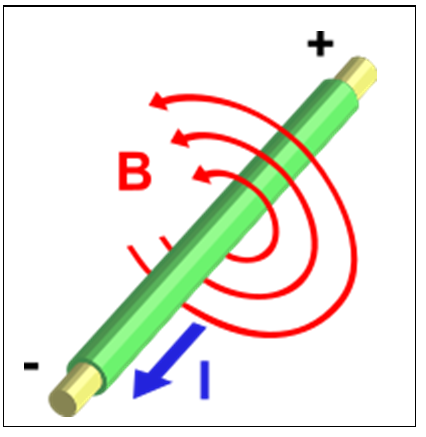
Magnetism was thought to be distinct from electricity until Maxwell’s equations were found to define both. A static charge isn’t magnetic but when it moves, a magnetic field appears around it (Figure 5.10). If you wrap a wire around a nail and pass a current through it, the nail becomes a magnet. The magnetism stops when the current stops, suggesting that electricity causes magnetism. And if you wrap a wire round a magnet and spin it, a current is induced in the wire, so by the same logic, magnetism causes electricity.
Hence light is said to be an electric field vibration sustained by the magnetic field vibration it creates, yet mutual causation is illogical! That electricity causes magnetism that causes electricity is just another mystery that physics has learned to accept.
Some argue that magnetism is charge in another guise (Note 1), but if so:
- Why don’t static charges and magnets interact?
- Why is magnetism at right angles to the electric field?
- Why doesn’t Gauss’s law apply to magnetism, as it decreases more like an inverse cube than an inverse square?
- Why does dividing a charged body give positive and negative charges but dividing a magnet gives two more magnets, both with a north and south pole?
Magnetism behaves very differently from charge but that Maxwell’s equations describe both implies that they are aspects of the same thing:
“We will see that magnetism and electricity are not independent things – that they should always be taken as one complete electromagnetic field.”(Feynman et al., 1977)
But that we can explain electric and magnetic fields separately doesn’t mean we can explain electromagnetism, any more than explaining horses and birds might explain a winged horse. That the same field can be electric or magnetic depending on reference frame doesn’t explain why it has two different effects (electric and magnetic) that have different directions and weaken differently. Some say we don’t need to explain if we have equations, but equations aren’t theories. The current situation is that physics has no credible theory of what electromagnetism actually is.
It is now said that when charges repel, virtual photons batter them apart and when they attract, virtual photons push them together. Magnetism quite works differently from charge but the same virtual photons are said to cause it as well. One gets the impression that as long as the equations work, physics would be happy to attribute electromagnetism to fairies with photon wands.
Quantum realism argues that matter bodies spread their quantum processing, nothing else, so it must derive both electric and magnetic fields from a single quantum field.
Note 1. The argument is that a moving electron’s length is foreshortened by special relativity giving more negative electrons than positive protons in a given length of wire, hence parallel wires with opposite currents attract. In quantum realism, this is correlation not causation